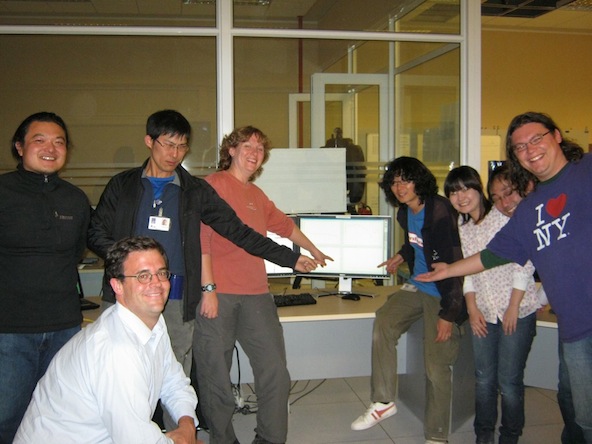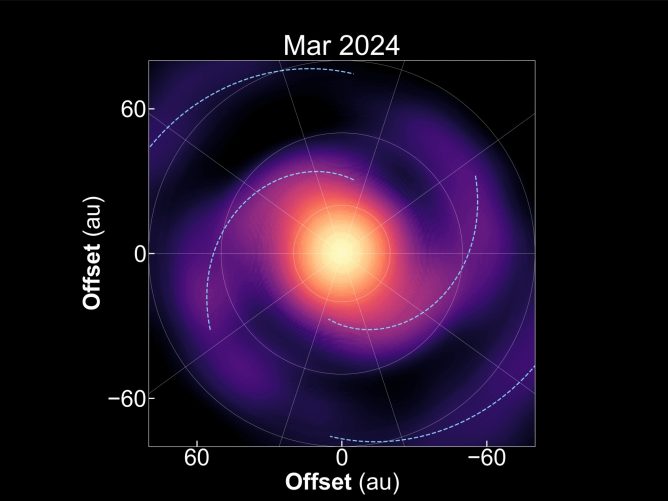The Atacama Large Millimeter/submillimeter Array (ALMA) has passed a key milestone crucial to producing the high-quality images that will be the trademark of this revolutionary new tool for astronomy. A team of astronomers and engineers successfully linked three of the observatory’s antennas at the 5000-meter elevation observing site in northern Chile. The three antennas observing in unison for the first time allowed the ALMA team to correct errors that can arise when only two antennas are used, thus paving the way for precise images of the cool Universe at unprecedented resolution.
On 20 November 2009 the third antenna for the ALMA observatory was successfully installed at the Array Operations Site, the observatory’s “high site” on the Chajnantor plateau, at an altitude of 5000 meters in the Chilean Andes. After complex technical tests over the subsequent weeks, astronomers and engineers were able to observe the first signals from an astronomical source making use of all three 12-meter diameter antennas linked together.
“We have successfully obtained fringes between antennas by simultaneously observing a single source with three antennas. This achievement is crucially important for the verification of the ALMA system design,” says Satoru Iguchi, the East Asian Project Manager for ALMA at NAOJ. “With two antennas, we cannot determine which antenna affects the performance of ALMA; however, with three antennas, we can understand how each antenna works for the performance of the entire ALMA system by comparing the data of each pair”
The successful linking of the three antennas was a key test of the full electronic and software system now being installed at ALMA, and its success anticipates the future capabilities of the observatory. When complete, ALMA will have at least 66 high-tech antennas operating together as an “interferometer”, working as a single, huge telescope probing the sky in the millimeter and submillimeter wavelengths of light. The combination of the signals received at the individual antennas is crucial to achieve images of astronomical sources of unprecedented quality at its designed observing wavelengths.
The three-antenna linkup is a critical step towards the observatory’s operations as an interferometer [1]. Although the first, successful measurements employing just two antennas were obtained at the ALMA high site in October 2009 and demonstrated the excellent performance of the instruments, the addition of the third antenna is a leap of vital importance into the future of the observatory.
To achieve this crucial goal, astronomers have observed the light coming from the from a distant extragalactic source, the quasar 1924-292, well known to astronomers for its bright emission at very long wavelengths, including the millimeter/submillimeter range probed by ALMA. The stability of the signal measured from this object shows that the antennas are working impressively well.
“In this interferometer test linking three antennas, we have verified the validity of the conceptual design of the ALMA system by obtaining the result in which atmospheric fluctuation was successfully counterbalanced,” explains Satoru, the East Asian ALMA Project Manager. “Our long-waited ALMA has now been activated as an interferometer at 5000 meters above sea level. We have only 3 antennas at this moment, but when 16 antennas are linked together, the sensitivities of ALMA will be 10 times higher than that of existing radio telescopes. We would soon be able to see exciting astronomical shows with ALMA.”
Notes
[1] Astronomers refer to the use of three (or more) elements in an interferometer as “closure phase”. This technique, first introduced by British radioastronomer Roger Clifton Jennison in 1958, has been extensively applied in astronomical interferometry since the mid 1970s, yielding high resolution images of astronomical sources at radio, infrared and optical wavelengths.
-

-
Three antennas installed at the ALMA Array Operations Site at 5000 meters
-

- Antennas during interferometer test
-

- Plot of the interferometer test. The horizontal axis is a frequency channel and the vertical axis is a signal phase difference (unit: radian). It was verified that three antennas successfully worked as an interferometer system since the closure phase of the three antennas became zero.
-

-
ALMA artist conception. Antennas are moved to various configurations by antenna transporters. When regular operations started, observations are conducted with antennas laid out in a configuration most suitable for the research purpose.
More Information
The Atacama Large Millimeter/submillimeter Array (ALMA), an international astronomy facility, is a partnership of East Asia, Europe, and North America in cooperation with the Republic of Chile. NAOJ is the East Asia partner in ALMA. ALMA, the largest astronomical project in existence, is a revolutionary telescope, comprising an array of 66 or more giant 12-meter and 7-meter diameter antennas observing at millimeter and submillimeter wavelengths. ALMA will start regular scientific observations in 2012.
More information about ALMA: ALMA observatory









